تضيف لوحة معلومات إدارة المشروع قيمة للفرق من خلال تقديم رؤى وتحديثات على مدار 24 ساعة في اليوم وطوال أيام الأسبوع. 🕐
تواجه الفرق الموزعة عقبات في الإدارة الفعالة للمشروع. حيث يصبح التواصل أكثر تعقيداً مع محدودية وقت التفاعل المتزامن للفرق أو مع تزايد بيانات المشروع.
من خلال تصورات البيانات في الوقت الفعلي وإعداد التقارير الآلية، تضمن لوحات معلومات إدارة المشروع إمكانية الوصول إلى معلومات المشروع المهمة في أي وقت وفي أي مكان.
قد يبدو إنشاء لوحة معلومات المشروع أمراً مخيفاً لأنه ينطوي على التخطيط وبعض أعمال التصميم. إذا لم تكن متأكدًا من العائد المحتمل على الاستثمار (ROI) مقابل الوقت والجهد المبذول في إنشاء لوحة معلومات، فمن المحتمل أنك تخشى أن تجعلها معقدة للغاية.
لقد سهّلت برامج لوحة معلومات المشروع الحديثة العملية، لذلك نحن نشارك أفضل الأمثلة والقوالب والنصائح لإنشاء لوحة معلومات ديناميكية! 📊
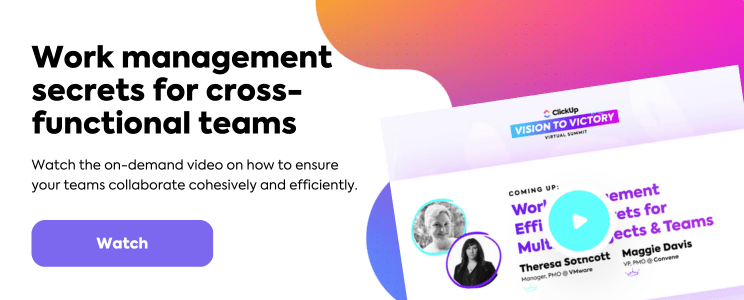
ما هي لوحة معلومات إدارة المشاريع؟
لوحة معلومات إدارة المشروع هي أداة مرئية مصممة لمساعدة الفرق على عرض أداء المشروع في موقع مركزي واحد. وهي تقدم المعلومات المتعلقة بالمشروع من خلال الرسوم البيانية والمقاييس، مما يسمح للجمهور بفهم حالة المشروع والتقدم المحرز والمخاطر المحتملة بسرعة.
غالبًا ما تكون العديد من المشاريع في السوق الحديثة اليوم مترابطة، مما يعني أن نتائجها ونجاحها مرتبطان ارتباطًا وثيقًا ببعضهما البعض. ويمكن أن يحدث هذا الترابط داخل المؤسسة الواحدة، حيث تعتمد مشاريع متعددة على موارد مشتركة, المخرجات أو الجداول الزمنية 🌐
يؤدي تنسيق المهام عبر مناطق زمنية مختلفة في بعض الأحيان إلى التأخير والإبطاء عمليات اتخاذ القرار . تؤدي هذه التحديات إلى سوء الفهم وعدم الالتزام بالمواعيد النهائية وانخفاض الإنتاجية.
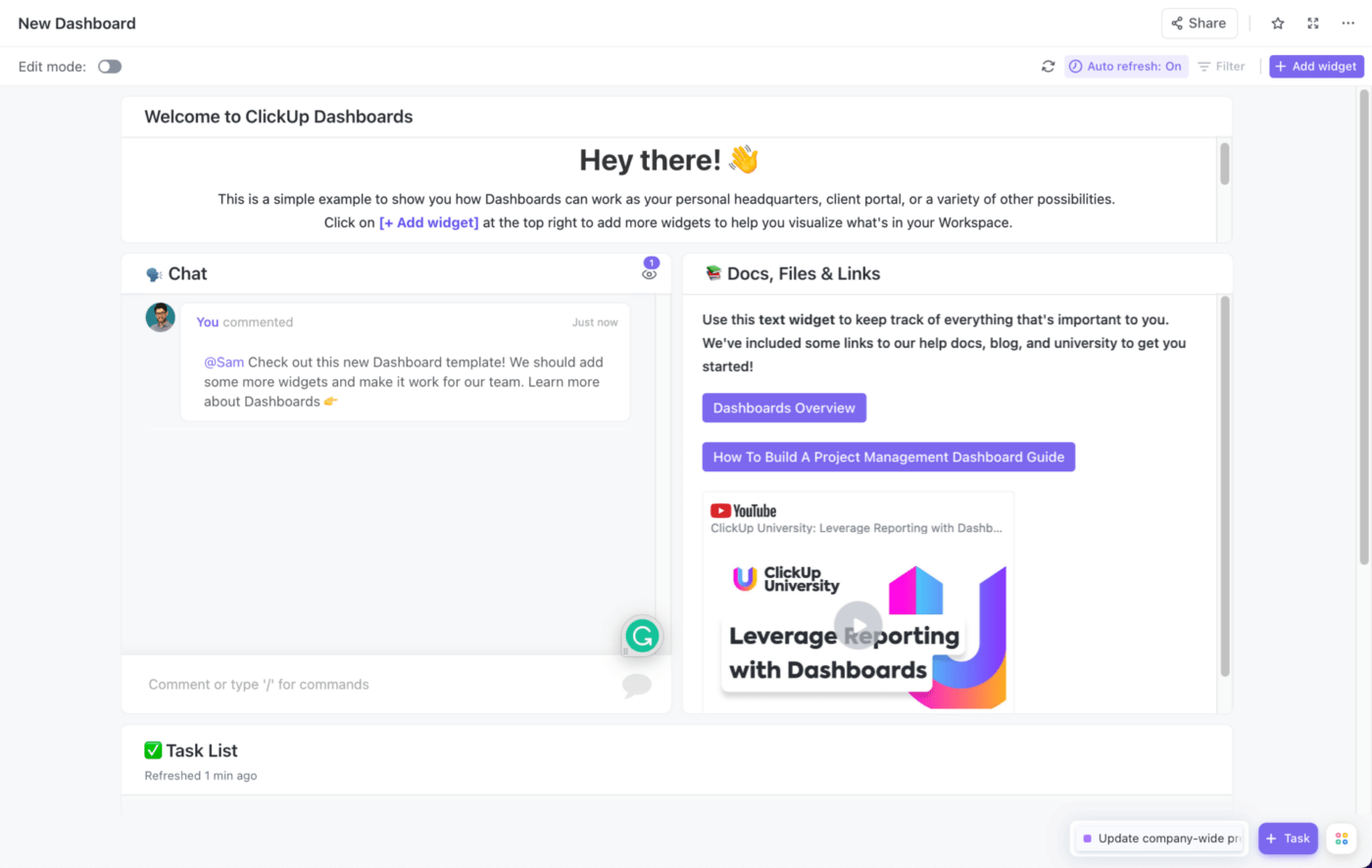
تتبع وإدارة المهام والموارد والتقدم المحرز في المشروع على لوحة معلومات ClickUp
ومع برنامج لوحة التحكم مثل ClickUp, جداول بيانات جوجل أو إكسل ، سيكون لديك مجموعة من خيارات التصور لتلبية احتياجات مشاريع محددة!
فيما يلي فوائد لوحات معلومات المشروع لتحسين أداء المشروع:
- رؤية محسّنة: توفر لوحات معلومات إدارة المشروع رؤية في الوقت الفعلي لحالة المشروع بشكل عام. يمكنك تحديد الاختناقات بسرعة، ومراقبة تقدم المهام، واكتشاف المشاكل المحتملة قبل أن تتفاقم
- تواصل أفضل: تسهل لوحات المعلومات التواصل الفعال بين أعضاء الفريق. يمكن الوصول إلى التحديثات على الفور، مما يبقي الجميع على نفس الصفحة ويعزز تعاون الفريق
- تتبع الأداء: من خلال أدوات التصور، يمكن للوحات المعلومات هذه تتبع مقاييس أداء المشروع بفعالية. ويمكنك قياس إنتاجية الفريق وميزانية المشروع وإدارة الوقت وغير ذلك الكثير
- القرارات المستندة إلى البيانات: من خلال توفير رؤية شاملة لبيانات المشروع، تمنح لوحات المعلومات مديري المشاريع السياق الصحيح لاتخاذ قرارات مستنيرة قائمة على البيانات. وهذا يساعد في تحسين تخطيط المشروع وإدارة المخاطر
- زيادة الكفاءة: تساعد القدرة على رؤية المهام والمواعيد النهائية والتبعيات في مكان واحد على تبسيط سير العمل. تعمل لوحات معلومات إدارة المشروع على تبسيط تخصيص المهام ومنع الاستخدام المفرط للموارد، مما يؤدي إلى زيادة كفاءة المشروع
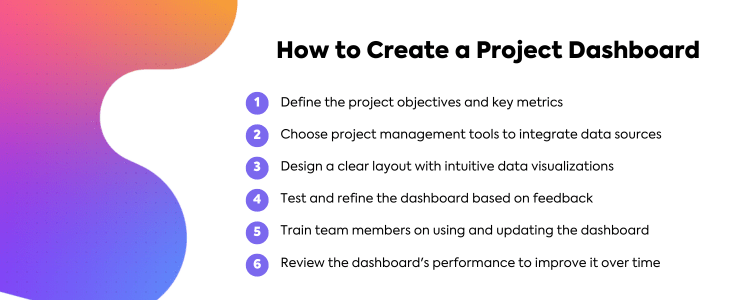
بصفتك إنساناً أولاً ومديراً للمشروع ثانياً، فإن تفردك هو أحد الأصول التي يمكن أن تؤدي إلى إدارة مبتكرة وناجحة للمشروع. اشعر بالقدرة على استكشاف برامج مختلفة للوحة معلومات إدارة المشاريع لاكتشاف ما يناسبك أنت وفريقك ومشاريعك! ⚡️
كيفية إنشاء لوحة معلومات المشروع مع أمثلة على ذلك ClickUp Dashboards بمثابة لوحة قابلة للتخصيص حيث يمكنك التفاعل مع البيانات من مختلف المهام والمشاريع وغيرها في مكان واحد. تسهّل لوحة المعلومات إدارة الموارد (مثل الأقسام الفردية والميزانيات والمعدات) المخصصة في مختلف هيئات العمل.
إليك كيفية إنشاء لوحة معلومات لإدارة المشاريع:
الخطوة 1: تحديد أهداف لوحة المعلومات ومؤشرات الأداء الرئيسية
ما هي نقاط الألم أو التحديات المحددة التي يواجهها الفريق؟ ما الذي تريد قياسه وتتبعه؟ بمجرد أن تكون الأهداف واضحة، يمكنك التركيز على نوع لوحة المعلومات التي يجب استخدامها.
اختر المؤشرات التي يمكن تتبعها بسهولة وتقديم قيمة فورية. من المهم أيضًا اختيار المقاييس ذات الصلة التي يهتم بها جميع أعضاء الفريق ويفهمونها. سيساعدك استخدام قالب في بناء العناصر المرئية للوحة المعلومات بسرعة. (ولكن المزيد عن هذا لاحقًا!)
الخطوة 2: اختر برنامج لوحة المعلومات
مع اختلاف أداة إدارة المشروع المتاحة، قد يكون من الضروري تجربة بعض الخيارات. ألقِ نظرة فاحصة على مدى سهولة استخدام الأداة، وقدرات التكامل مع الأنظمة الحالية، وقابلية التوسع، وتدابير أمن البيانات. من المفيد أيضًا إعطاء الأولوية لأداة إدارة المشروع التي تتوافق و تحسين سير عمل الفريق . ⚙️
وليس عليك أن تخوض هذه العملية بمفردك! اطلب من أعضاء فريق المشروع الرئيسيين مشاركة وجهات نظرهم حول كيفية إضافة لوحة المعلومات قيمة لعملهم. ستحصل على فكرة أفضل عن ميزات لوحة المعلومات الرئيسية التي يجب البحث عنها.

تتيح لك فلاتر المجموعات المختلطة في لوحات معلومات ClickUp Dashboards إمكانية التخصيص والتخصيص باستخدام عاملي "و" و"أو"
الخطوة 3: تصميم تخطيط لوحة المعلومات
قم برسم تخطيط لوحة المعلومات الخاصة بك، مع الأخذ في الاعتبار احتياجات جمهور لوحة المعلومات الخاصة بك (الفرق, أصحاب المصلحة أو العملاء). الاستفادة من المخططات والرسوم البيانية والتصورات الأخرى لتقديم البيانات بأفضل طريقة ممكنة. 🎨
حاول الحد من عدد العناصر في لوحة المعلومات الخاصة بك، مع التأكد من التركيز على المقاييس الأكثر أهمية. سيساعد ذلك المستخدمين على التعرف بسرعة على مؤشرات الأداء الرئيسية (KPIs) واتخاذ قرارات مستنيرة بشكل أسرع.
في هذه المرحلة، من المهم أيضًا تحديد من يمكنه الوصول إلى لوحة معلومات إدارة المشروع وعلى أي مستوى يمكنهم التفاعل مع البيانات. على سبيل المثال، يمكنك السماح لأعضاء الفريق بمشاهدة لوحة التحكم ولكن مع تقييدهم من التحرير أو إجراء تغييرات.
تعلم
_مراجع/ https://clickup.com/blog/dashboard-examples-in-clickup// كيفية إنشاء لوحة تحكم ClickUp Dashboard %/%href/_
تحقق من توقعاتك التصميمية والوظيفية_*_
الخطوة 4: بناء مكونات لوحة المعلومات
ابدأ في بناء مكونات لوحة المعلومات بناءً على مؤشرات الأداء الرئيسية المحددة وهيكل البيانات. استخدم ميزات السحب والإفلات في برنامج لوحة المعلومات لترتيب لوحة المعلومات وإجراء التعديلات أثناء تقدمك.
بمجرد وضع المكونات في مكانها، حان الوقت لتخصيص لوحة المعلومات. استخدم الألوان والإشارات المرئية الأخرى لإبراز العناصر أو الاتجاهات الرئيسية في البيانات. سيساعدك هذا على التركيز على ما هو أكثر أهمية لفريقك و أهداف المشروع . 🏆
يمكنك أيضًا إضافة عناصر تفاعلية مثل الأزرار والقوائم المنسدلة للسماح للمستخدمين بتصفية بياناتهم وتقسيمها في الوقت الفعلي. ستمنح هذه الميزات المستخدمين تحكمًا أفضل في البيانات وتسمح لهم باستكشاف المزيد من الرؤى والاتجاهات.
مكافأة:_
_/مرجع/ https://clickup.com/blog/excel-kpi-dashboard// _لوحة معلومات مؤشرات الأداء الرئيسية لبرنامج Excel* %/%href/_
!

تتيح لك البطاقات المخصّصة في لوحات معلومات ClickUp Dashboards تتبع التقدم المحرز مقابل الساعات أو نقاط السباق التي خططت لها في الأصل
الخطوة 5: مشاركة وجمع الملاحظات
قبل نشر لوحة المعلومات على الفريق بأكمله، احصل على تعليقات من أصحاب المصلحة الرئيسيين وأعضاء الفريق لتحديد أي تحسينات أو ميزات إضافية يمكن أن تعزز فائدة لوحة المعلومات. ستحتاج إلى معرفة ما إذا كانت هناك معلومات مفقودة عن المشروع أو بيانات مشوشة أو مكونات غير واضحة.
بمجرد تلقي التعليقات ودمجها، شارك لوحة المعلومات مع الفريق بأكمله لاستخدامها في تتبع تقدم المشروع. تأكد من أن الجميع يعرف كيفية قراءة لوحة المعلومات وتفسيرها حتى يتمكنوا من تحديد الاتجاهات بسرعة واتخاذ الإجراءات اللازمة وفقًا لذلك. ✍️
وأخيراً، خطط لإجراء مراجعات منتظمة للوحة معلومات المشروع. سيساعد ذلك على ضمان إطلاع جميع أصحاب المصلحة على آخر المستجدات بشأن التقدم المحرز وأي تغييرات تم إجراؤها. كما سيسمح لك ذلك أيضًا بالتقاط رؤى جديدة أو تعديل لوحة المعلومات حسب الحاجة.

استخدم التنقل لأسفل في لوحات معلومات ClickUp Dashboards لتغيير المهام أو تحديثها داخل المخطط لإجراء تعديلات سلسة
3 قوالب للوحة معلومات المشروع لجمهورك الرئيسي
تتمثل إحدى مزايا استخدام قالب لوحة معلومات المشروع في مرونته وقابليته للتكيف لتلبية احتياجات المشروع وحالات الاستخدام المتنوعة.
يعمل قالب لوحة المعلومات المصمم بشكل جيد كأساس يمكن لمديري المشاريع تخصيصه بناءً على المتطلبات المحددة لحملاتهم الفردية أو محفظة مشاريعهم. 👩💻
1. قالب لوحة معلومات إدارة مشروع ClickUp لإدارة المشاريع
الأفضل لتتبع الأداء عبر جميع مشاريعك
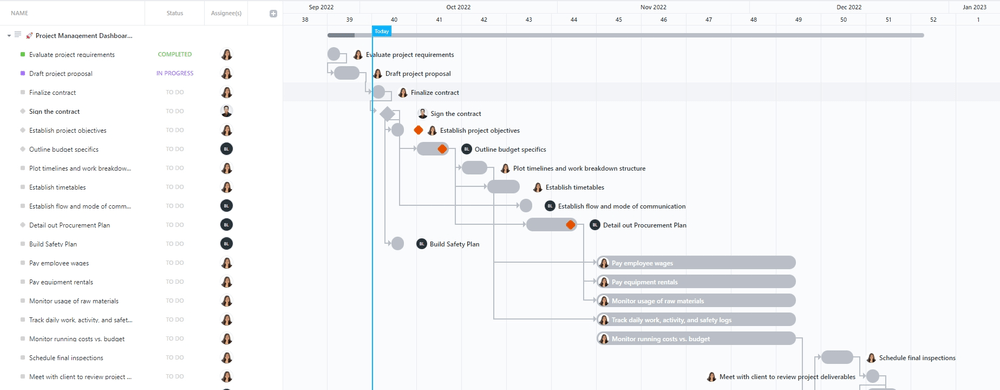
افتح عرض ClickUp الجدول الزمني كلوحة معلومات لحالة المشروع
الـ قالب لوحة معلومات إدارة المشاريع ClickUp أداة قوية لبدء تشغيل لوحات المعلومات المخصصة. وهي توفر أنواعًا مختلفة من طرق العرض، بما في ذلك مخطط جانت، للبقاء منظمًا طوال المشروع. وبفضل ميزات التعاون البديهية، وتتبع المهام، وخيارات التخصيص، فإنها تعمل على تبسيط إدارة المشروع واتخاذ القرارات.
يمكن لمديري المشاريع تخصيص الموارد بكفاءة، ومراقبة التقدم المحرز، وتكييف لوحة المعلومات لتناسب أنواع المشاريع المختلفة. يعمل القالب كمحور مركزي لبيانات المشروع، مما يعزز التنظيم والتعاون بشكل أفضل في كل مرحلة من مراحل المشروع! 🤝
2. انقر فوق قالب خطة إدارة المشاريع عالية المستوى
الأفضل لتتبع المخرجات عبر الفريق بأكمله
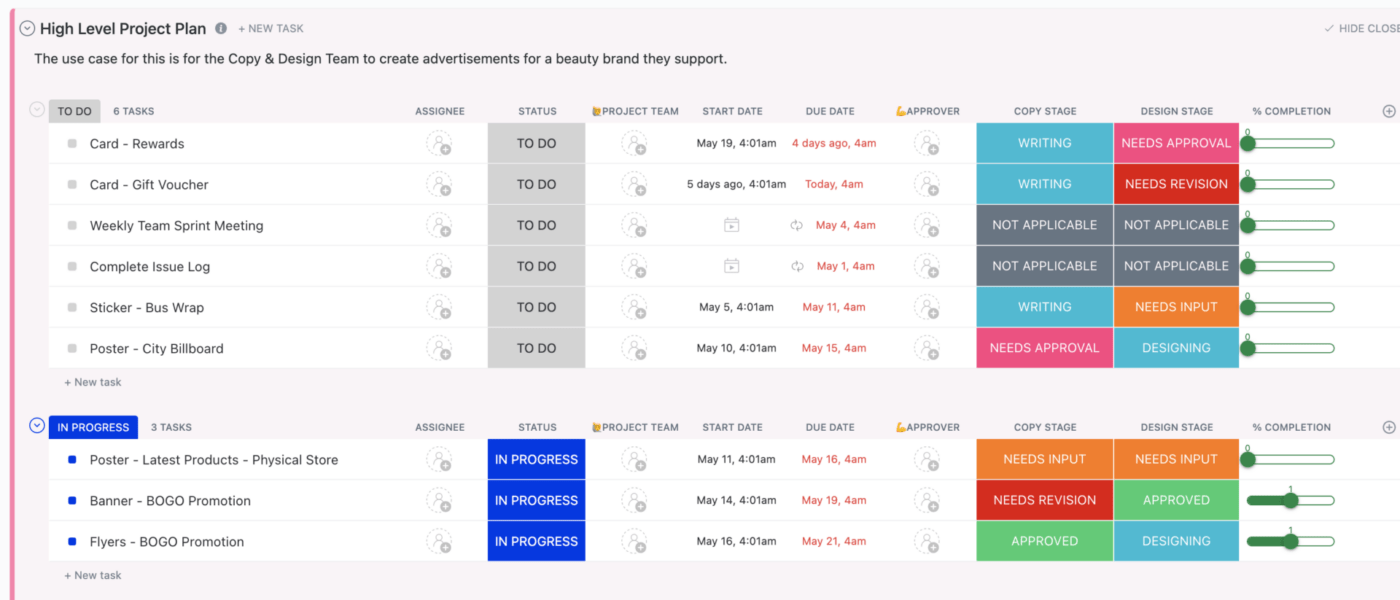
الخطوط العريضة لـ نطاق المشروع ومقاييس المشروع لمشاركتها مع فريق القيادة في ClickUp
تعد الخطط عالية المستوى ضرورية لبدء المشروع، وتسهيل تحديد نطاق المشروع، والتواصل الفعال مع أصحاب المصلحة، وكسب التأييد. فهي تمكّن الفرق من التكيف مع التغييرات وتحديد الأولويات اتخاذ القرارات الاستراتيجية دون أن تغرق في التفاصيل المعقدة. 📃
إن قالب خطة المشروع عالية المستوى من ClickUp هو النموذج المثالي أداة مرئية لإدارة المشاريع لتحديد أهداف المشروع وتخصيص الموارد ووضع أولويات واضحة للفريق. تتيح طريقة عرض القائمة لمديري المشاريع إنشاء قائمة منظمة بالمهام والمخرجات، مما يسهل تحديد أهداف المشروع وغاياته!
3. انقر فوق قالب تقرير حالة المشروع التنفيذي
الأفضل لمشاركة تقدم المهام مع أصحاب المصلحة والقادة الرئيسيين
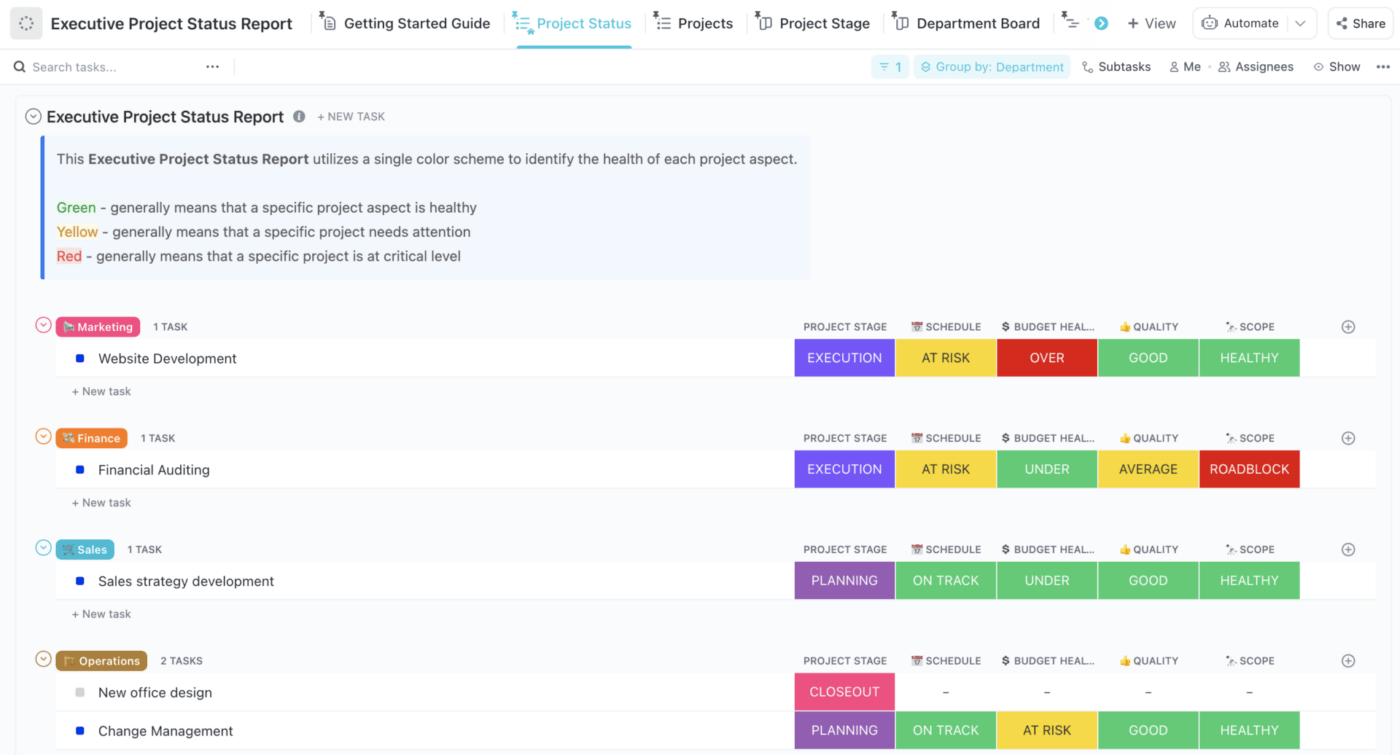
استخدم أدوات لوحة معلومات إدارة المشروع في ClickUp لمواءمة أصحاب المصلحة في مكان واحد
يحتاج المديرون التنفيذيون إلى لوحة معلومات المشروع للحصول على رؤية في الوقت الفعلي لمشاريع المؤسسة. من خلال نظرة عامة مركزية يسهل الوصول إليها عن تقدم المشروع ومؤشرات الأداء الرئيسية والاختناقات المحتملة، يمكن للمديرين التنفيذيين اتخاذ قرارات مستنيرة و في الوقت المناسب. ⏳
نظام قالب تقرير حالة المشروع التنفيذي من ClickUp يحل محل رسائل البريد الإلكتروني الأسبوعية الخاصة بالحالة التي تتراكم على مدار المشروع. حيث يمكنهم الحصول على رؤية شاملة لتقدم المشروع والمقاييس الرئيسية والمخاطر المحتملة. مع إعداد انقر فوق الحقول المخصصة وطريقة عرض المهام المختلفة، يبسّط هذا القالب عملية الإشراف على مشاريع متعددة في المحفظة في نفس الوقت.
تحقق من المزيد قوالب الملخص التنفيذي !
7 أنواع من لوحات المعلومات للمشاريع الناجحة ## 7 أنواع من لوحات المعلومات للمشاريع الناجحة
مع وجود مجموعة متنوعة من أنواع لوحات المعلومات تحت تصرفنا، غالبًا ما يكمن التحدي في اختيار النوع المناسب الذي يتماشى مع الاحتياجات والأهداف الفريدة للمشروع.
أفضل لوحات معلومات إدارة المشاريع لها أهداف واضحة المعالم. قد تؤدي محاولة تغطية الكثير من الأمور إلى إعاقة الإنتاجية وصنع القرار ونجاح المشروع
إليك سبعة أنواع أخرى من لوحات المعلومات لإضافتها إلى مجموعة أدوات الإنتاجية الخاصة بك!
1. لوحة متابعة تقدم المهام
تعد لوحة معلومات تقدم المهام أداة مهمة لتتبع الحالة الحالية للمشروع. تتميز لوحة المعلومات هذه عادةً بمخطط بياني للمهام والتقدم المحرز فيها، مما يسمح لمديري المشروع بمراقبة مقدار ما تم إنجازه والخطوات التالية التي ينبغي اتخاذها. وقد تتضمن بيانات عن تواريخ الإنجاز المقدرة مقابل تواريخ الإنجاز الفعلية لتوفير مزيد من الوضوح في أداء الفريق.
2. لوحة معلومات تتبع الميزانية
تُعد لوحة متابعة تتبع الميزانية أمرًا ضروريًا للبقاء على اطلاع على نفقات المشروع. يتميز هذا النوع من لوحات المعلومات عادةً بنقاط بيانات مثل إجمالي التكاليف والنفقات المتوقعة والأموال المتاحة. بالإضافة إلى ذلك، قد توفر أيضًا معلومات حول التكلفة لكل مهمة أو مورد للمساعدة في تحديد أي مشاكل محتملة في الميزانية و/أو الإنفاق. 💰
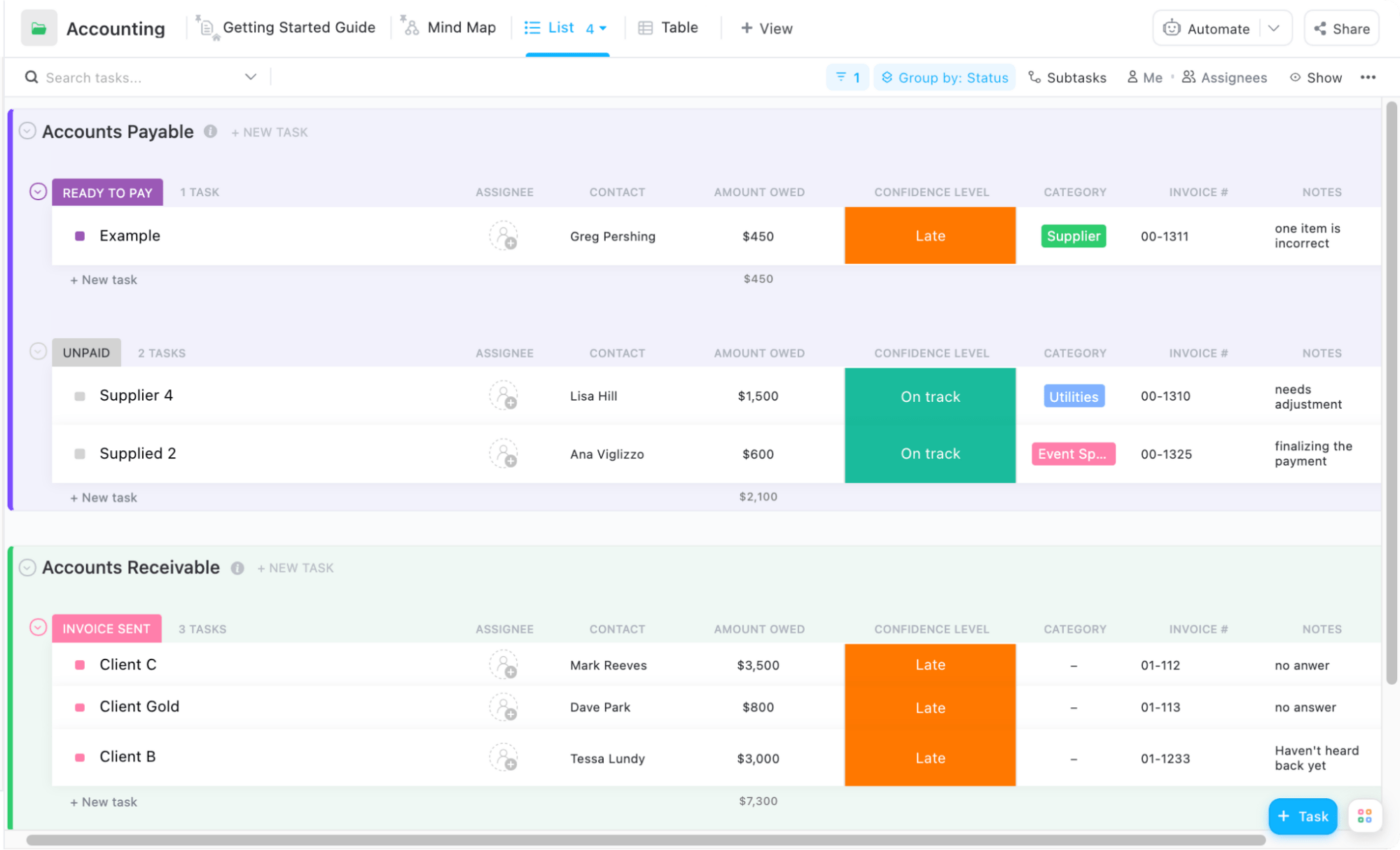
نظِّم البائعين والمدفوعات والمهام وغير ذلك باستخدام قائمة ClickUp
3. لوحة معلومات إدارة المخاطر
تُعد لوحة معلومات إدارة المخاطر ضرورية للتحضير للمخاطر المحتملة والتخفيف من حدتها أثناء سير المشروع. يوفر هذا النوع من لوحات المعلومات لمحة عامة عن جميع المخاطر المحددة وخطط التخفيف المرتبطة بها، مما يسمح لمديري المشروع بتعديل استراتيجيتهم بسرعة في حالة ظهور أي تهديدات جديدة. بالإضافة إلى ذلك، فهي تساعد على إبقاء الفريق مركزًا على القضايا ذات الأولوية القصوى التي تضر بالتقدم.
4. لوحة متابعة أداء الفريق
تراقب لوحة متابعة أداء الفريق التقدم الذي يحرزه أعضاء الفريق كل على حدة، مما يسمح لمديري المشروع بتحديد المشكلات المحتملة أو المجالات التي تحتاج إلى تحسين. قد يتضمن هذا النوع من لوحات المعلومات بيانات عن أوقات إنجاز المهام ودقة المهام وغيرها من المقاييس المتعلقة بإنتاجية الفريق.
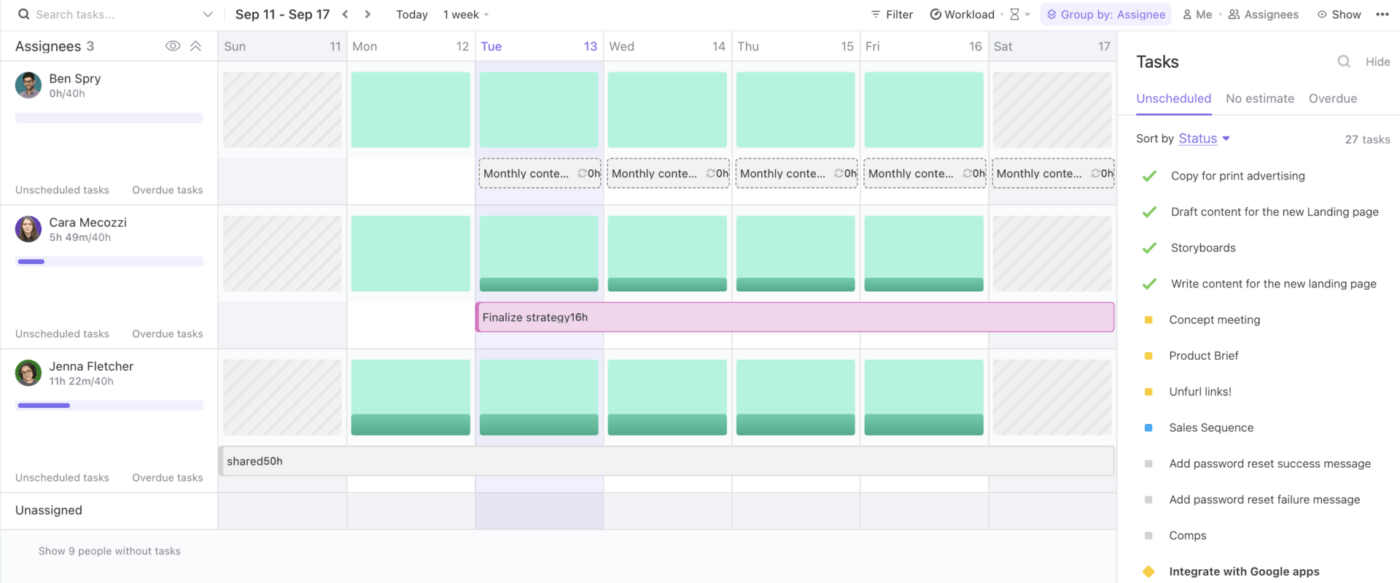
تتبع المهام عبر فرق المشروع في طريقة عرض عبء العمل ClickUp Workload
5. لوحة تحكم اتصالات العملاء
تعد لوحة معلومات التواصل مع العملاء ضرورية للبقاء على اطلاع على أي أسئلة أو ملاحظات من عملائك. يعمل هذا الدمج على تبسيط عملية الوصول إلى المعلومات ذات الصلة، مما يلغي الحاجة إلى المرور عبر قنوات الاتصال المختلفة، مثل رسائل البريد الإلكتروني والمكالمات الهاتفية وحتى رسائل وسائل التواصل الاجتماعي! 👥
6. لوحة معلومات تخصيص الموارد
على عكس لوحة متابعة أداء الفريق، فإن لوحة متابعة تخصيص الموارد ضرورية لتقييم توزيع الموارد على مختلف المشاريع أو المهام. بحيث يكون هناك توزيع عادل ومتوازن يتماشى مع أولويات المشروع والأهداف التنظيمية. يوفر هذا النوع من لوحة المعلومات عرضًا عالي المستوى لـ أين يتم استخدام الموارد، مما يسمح لمديري المشاريع بتحديد أي أوجه قصور محتملة بسرعة.
7. لوحة معلومات تتبع المشكلات والأخطاء
تُعد لوحة معلومات تتبع المشكلات والأخطاء أداة لا تقدر بثمن لتحديد ومراقبة وحل أي مشكلات أو أخطاء تتم مواجهتها أثناء سير المشروع. يوفر هذا النوع من لوحات المعلومات عرضًا مركزيًا للمشكلات الحالية ويوفر بيانات عن التقدم المحرز في كل مهمة مرتبطة بها. 📈
والأهم من ذلك أنه يمكن أن يساعد في منع التأخيرات المكلفة من خلال تنبيه مديري المشاريع عند اقتراب المواعيد النهائية ولم يتم البدء في العمل.
![]()
بناء لوحة تحكم برنامج إدارة المشاريع لتتبع الأخطاء والطلبات الواردة
قيادة نجاح المشروع باستخدام لوحات معلومات ClickUp Dashboards
من خلال واجهة سهلة الاستخدام وميزات السحب والإفلات البديهية، يمكنك التحكم الكامل في إعداد لوحة معلومات مشروعك في ClickUp حسب تفضيلاتك. لا داعي للقلق بشأن التدريب المكثف أو الإعدادات المعقدة! تقدم ClickUp قوالب معدة مسبقًا وخطوات تخصيص سهلة المتابعة.
أنشئ حساب ClickUp مجانًا اليوم وادعُ المتعاونين معك لاستكشاف المنصة! 🔍

